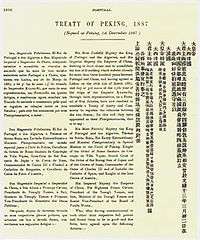Sino-Portuguese Treaty of Peking
| Sino-Portuguese Treaty of Peking | |||||||||||
|
Sino-Portuguese Treaty of Peking | |||||||||||
| Chinese name | |||||||||||
|---|---|---|---|---|---|---|---|---|---|---|---|
| Traditional Chinese | 中葡和好通商條約 | ||||||||||
| |||||||||||
| Alternative Chinese name | |||||||||||
| Traditional Chinese | 中葡里斯本草約 | ||||||||||
| |||||||||||
| Portuguese name | |||||||||||
| Portuguese | Tratado de Amizade e Comércio Sino-Português | ||||||||||
Sino-Portuguese Treaty of Peking, signed December 1, 1887, was an unequal trade treaty between the Kingdom of Portugal and Qing dynasty China.[1]
Signing
On 13 August 1862, an attempt was made between China and Portugal to sign a trade treaty in Tientsin. If the treaty was not ratified in two years, it would become null. In 1864 the treaty did become null. Portugal did not get another chance to sign the second article of the treaty until March 26, 1887 in Lisbon.[1] An envoy was sent from Portugal to China. The protocol was signed by Sun Xuwen from the Chinese side and Tomás de Sousa Rosa for Portugal on December 1, 1887.[1]
Interpretations
According to the Portuguese interpretation, sovereignty over Macau was surrendered to Portugal. In the Chinese interpretation, only administrative rights were transferred. Macau territory was returned to Chinese rule on December 20, 1999.[2]
See also
References
- 1 2 3 Ride, May. Wordie, Jason (1989). The Voices of Macao Stones. Hong Kong University Press. ISBN 962-209-487-2, ISBN 978-962-209-487-1.
- ↑ Page, Melvin Eugene. Sonnenburg, Penny M.(2003). Colonialism: an international, social, cultural, and political encyclopedia. ABC-CLIO publishing. ISBN 1-57607-335-1, ISBN 978-1-57607-335-3. p 359.
